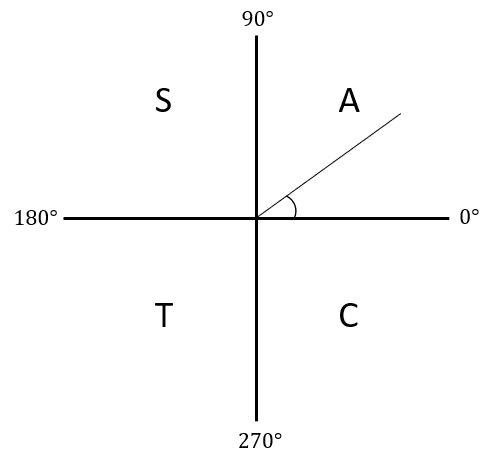Trig Equations
Trig Equations Revision
Trig Equations
Solving the basic trig equations is pretty easy, but what happens if we’ve got a function which has been stretched or translated?
Make sure you are happy with the following topics before continuing.
Inspection
First, we need to find an initial solution.
So, for example, let’s say we want to find the values of x when \textcolor{red}{\tan x} = \textcolor{purple}{\dfrac{1}{\sqrt{3}}}.
We want to draw the graph, and mark on a horizontal line where the condition is met, i.e. where \textcolor{red}{\tan x} = \textcolor{purple}{\dfrac{1}{\sqrt{3}}}.
By inspection, we know that the initial solution is at 30°, and we can see it repeats at every 180°.
We’ll denote this 30° ± 180°n.
CAST Diagrams
The CAST diagram is a handy tool to show us where values of the standard trig functions are positive.

So, here’s the breakdown:
- For 0° < x < 90°, ALL of \textcolor{blue}{\sin x}, \textcolor{limegreen}{\cos x} and \textcolor{red}{\tan x} are positive
- For 90° < x < 180°, ONLY \textcolor{blue}{\sin x} is positive
- For 180° < x < 270°, ONLY \textcolor{red}{\tan x} is positive
- For 270° < x < 360°, ONLY \textcolor{limegreen}{\cos x} is positive
Think back to plotting the Unit Circle, in the Trig Basics section.
Let’s say we want to find the values of x such that \textcolor{red}{\tan x} = \textcolor{purple}{\dfrac{1}{\sqrt{3}}}, as before.
We know that there is a solution when x = 30°.
First, we plot the point on the diagram, then find the corresponding angles:

From here, we can see that \textcolor{red}{\tan x} = \textcolor{purple}{\dfrac{1}{\sqrt{3}}} when x = 30° ± 360°n or 210° ± 360°n, or, more concisely, 30° ± 180°n.
We ignored the two solutions where \textcolor{red}{\tan x} is not positive, i.e. 90° < x < 180° and 270° < x < 360°.
Dealing With Trig Transformations
Transformations pose a little bit of a problem… See, CAST diagrams become much harder to navigate now. You’re much better off sketching out the function and solving using the horizontal line technique.
So, let’s just begin with an example.
We have f(x) = \cos 3x. Find the values of x \in \lbrack 0°, 360°\rbrack * such that f(x) = \textcolor{purple}{\dfrac{1}{2}}.
* This is just set notation, meaning 0° \leq x \leq 360°
Well, we have a series of solutions, but they’re not immediately obvious.
What we can do instead is plot the regular \textcolor{limegreen}{\cos x} graph on an interval three times as large as the proposed interval, and divide our solutions there by 3.
\textcolor{limegreen}{\cos x} = \textcolor{purple}{\dfrac{1}{2}} has solutions 60°, 300°, 420°, 660°, 780°, 1020°.
Therefore, \cos 3x = \textcolor{purple}{\dfrac{1}{2}} has solutions 20°, 100°, 140°, 220°, 260°, 340°.
Trig Equations Example Questions
Question 1: Sketch the \sin x graph and by inspection, find the solutions of \sin x = \dfrac{-\sqrt{3}}{2}, in the interval -360° \leq x \leq 360°.
[2 marks]
x = \sin ^{-1} \left( \dfrac{\sqrt{3}}{2}\right) = -120°, -60°, 240°, 300°
Question 2: Using a CAST diagram, find the values of x such that \cos x = 0.2588.
[2 marks]
\cos x = 0.2588 gives x = 75°.
 By the CAST diagram, we can see that we also have a solution where x = 270° + 15° = 285°.
By the CAST diagram, we can see that we also have a solution where x = 270° + 15° = 285°.
Question 3: For f(x) = 2\sin \dfrac{3x}{2}, find the values of x \in \lbrack -2\pi, 2\pi \rbrack where f(x) = 1.
[4 marks]
For f(x) = 1, we want \sin \dfrac{3x}{2} = \dfrac{1}{2}.
If we look for values of -3\pi \leq x \leq 3\pi where \sin x = \dfrac{1}{2}, and multiply our values of x by a scale factor of \dfrac{2}{3}, we have our new set of solutions.
\sin x = \dfrac{1}{2} occurs at \dfrac{-11\pi}{6}, \dfrac{-7\pi}{6}, \dfrac{\pi}{6}, \dfrac{5\pi}{6}, \dfrac{13\pi}{6}, \dfrac{17\pi}{6}
Therefore the solution of f(x) = 1 is x = \dfrac{-11\pi}{9}, \dfrac{-7\pi}{9}, \dfrac{\pi}{9}, \dfrac{5\pi}{9}, \dfrac{13\pi}{9}, \dfrac{17\pi}{9}.
Trig Equations Worksheet and Example Questions
Sin cos and tan
A LevelYou May Also Like...

MME Learning Portal
Online exams, practice questions and revision videos for every GCSE level 9-1 topic! No fees, no trial period, just totally free access to the UK’s best GCSE maths revision platform.






